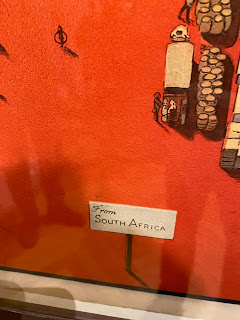Bodo, Norway, at 2am on June 21 this year.
In the three pandemic years ending this month, I have traveled to twenty-one countries on four continents. I was going to write about traveling this year, the third year of COVID-19, but decided that travel this year is a continuation of the strange travel during all of the pandemic. Since February of 2020, I visited twenty-one countries, seven countries for the first time: four in 2020, three in 2022.
From Arctic Norway on the summer solstice to winter in Israel to equatorial Bogata, Columbia, to southeast Poland, to the Republic of Georgia, I made eight trips overseas between February of 2020 and December of this year.
The cemetery at Omaha Beach in Normandy, France. I visited in 2017
In the three years before the pandemic, from 2017 to 2019, I was in twenty-nine countries, twenty of them for the first time. Over the six years from 2017 to 2022, I was in thirty-nine different countries, twenty-seven for the first time, on five continents (I haven't been to Australia since 2000).
Half of the countries I visited for the first time were part of a five-week trip in 2017. It was my first trip to Eastern Europe. I rode a bicycle from Belgrade, Serbia, to Lviv, Ukraine. On that ride I passed through nine countries. After the ride I visited Israel, Monaco and Sweden for the first time, plus returning to nine more countries I had visited before.
In his book Doom Niall Ferguson says he was warning colleagues in late January 2020 that a real pandemic was coming from China and would sweep the world. He was ignored. He and his colleagues went to the annual Davos conference in early February--the attendees were dismissive. It was the flu. It was a replay of SARS from the early 2000s. Ferguson was right. The Davos consensus was wrong.
My February-March 2020 trip was haunted by the looming pandemic. I arrived in Europe February 12, landing in Paris. I took a train to Darmstadt, Germany, where I met my friend Cliff. We flew from Frankfurt to Israel by way of Rome. In the Rome airport we were escorted through the terminal by a woman who could have been a Drill Sergeant.
Of all of Europe, the pandemic was at its worst in Italy. We just made our connecting flight and flew to Tel Aviv. In Jerusalem we stayed inside the walls of the Old City. We heard that a whole plane of Korean tourists was sent home because of COVID on the plane. We continued with our tour plans. A week later, I flew to the Republic of Georgia. Cliff flew home.
I was supposed to visit Kyiv next, but went straight to Athens instead because of COVID reports in Ukraine. I was supposed to visit Rome after Athens, but stayed in Athens a full week, taking a fast car trip to North Macedonia and Bulgaria. After Athens was supposed to be Rwanda. But then I thought it would be more difficult to travel from Africa if COVID got worse. So I went to the Pyrenees for a few days, then back to Paris.
America closed its borders on Friday the 13th in March 2020. Paris started closing around me. My ticket home was for the 17th and was cancelled on that day. I decided to wait and not join the tens of thousands of people trying to return to America on full planes and customs lines a mile long.
There are worse places to be stuck than Paris. It turns out bakeries are an essential service in France. I had lovely bakery takeout food to eat while I rode the empty streets of Paris. My plane left on time and not crowded after all. JFK airport was empty on the 17th of March. I made a one-way car rental and drove home.
Since the vaccine became available, travel in other countries meant changing rules at each border. But the rules were clear and people complied. Poland and the UK were very relaxed. Germany required masks on trains and planes right up to September of 2022. Brazil still mandates masks on public transportation.
Outside the U.S. I could know what the rules were and expect those around me would follow the rules. In America, every boundary was a new policy. In Lancaster, Pennsylvania, where I live, COVID policy was different in the city than in the rest of the county. It was true all over the country.
I had no trouble with COVID policy outside America. But inside America, the erratic policy led me to stay away from Red States, except one trip to see the Circuit of the Americas Formula 1 race track in Texas.
For me, traveling in Red State America was the risk not worth taking. Through 2021 and 2022, the anti-vaxxers clogged hospitals. People who needed other treatments could not get care in facilities overwhelmed with idiots.
When I first heard about the pandemic, a doctor I respect very much said the pandemic would last three years then we would start living with it. He was right. In the coming year, I expect COVID will be in the background in most of the free world. The countries ruled by tyrants, not so much.































































